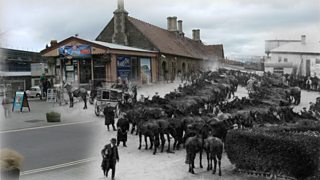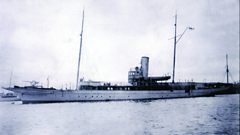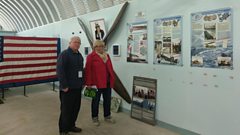Ordnance Road, Coventry: Ordnance Works
A leading munitions centre where a quarter of British aircraft was manufactured
During the war, Coventry became a hub of munitions production. The factories were described as industrial beehives and it was later suggested that: “no other city was so completely absorbed in the production of munitions.”
Half way up the Stoney Stanton Road on a road called Ordnance Road there are still some remnants of the original factory walls of the Ordnance Works.
The Coventry Ordnance Works was founded in 1905 and were already manufacturing guns before the war so they were well placed and expanded quickly to take on all kinds of contracts.
The site was vast with many different sheds for making a variety of different armaments for the navy and the army: gauges, tools, guns, gun wheels and large naval guns. The staff worked shifts for production to continue around the clock.
These large guns (pictured) were brought out of the factory on a railway line across the Stoney Stanton Road. They were so big they took up the width of the road. Members of the public would come out and see these guns made in Coventry that were going to defeat the enemy.
Defeating the enemy was on many a fit and healthy man’s mind right from when war was declared and their enthusiasm risked putting pressure on the workforce; as Karen Hunt, Professor of Modern History at Keele University, explains: “When war was declared there was a rush to the colours; fit and healthy men volunteered but that left a hole in the workforce.”
It was this rush to the colours that prompted a letter from Sir Admiral Bacon, the manager of the Coventry Ordnance Works to his workers.
Karen continues: “He was asking for them to stay and reassuring the workforce that it was better for them to stay put ‘to ensure that this war is over as quickly as possible’.”
But the war didn’t end quickly. Shortly after Admiral Bacon sent that letter, he left the company to return to active service. In the years that followed the problems in the factories changed and some skilled men left. With their absence, anxiety arose about who would replace them and if the jobs would be available to them if and when they returned.
“In the period that followed, we start to see the first deals being made between the government and trade unions to control unskilled or less skilled men, which meant that workers would only have their jobs for the duration of the war,” says Karen.
Flash forward to 1917, three years into the war and there was industrial unrest across the country, particularly in Coventry. By the end of November 1917; strikes in many of the factories, including the Ordnance Works, begin which get a large amount of national attention and factory workers were snubbed or ironically ‘sent to Coventry’.
Military pilots flew over Coventry dropping leaflets and handbills in Broadgate and thousands across different parts of the city. The handbill read “Make the Machines! We will Fly them! Aeroplanes are going to Win the War! The Pilots.”
What was the outcome of the strikes, what did they achieve?
Karen explains: “From the point of view of the government the strike only lasted a couple of days. Some of those who led the strikes found themselves sacked in early stages of 1918. From the point of view of the workers themselves, they’ve also seen what in a short time they can do. But the strikes didn’t end, strikes continued into June 1918.”
The period after the war was difficult for the Coventry Ordnance Works: the war contracts came to an end and they struggled to maintain business. They became part of English Electric in 1918. A century on, the original site still houses an industrial estate of small businesses.
Location: Ordnance Road (with remnants of Red Lane Industrial Estate) , Coventry CV6 5DR
Image shows a female munitions worker lifted into the barrel of a 15-inch naval gun manufactured at the Ordnance Works during WW1 in order to clean the rifling.
Photograph courtesy of Imperial War Museums
Presented by Phil Upton
Duration:
This clip is from
Featured in...
![]()
�鶹������ҳ��� Coventry & Warwickshire—World War One At Home
Places in Coventry & Warwickshire that tell a story of World War One
![]()
Working for the War
The production boom that fuelled the frontline
More clips from World War One At Home
-
![]()
The loss of HMY Iolaire
Duration: 18:52
-
![]()
Scotland, Slamannan and the Argylls
Duration: 07:55
-
![]()
Scotland Museum of Edinburgh mourning dress
Duration: 06:17
-
![]()
Scotland Montrose 'GI Brides'
Duration: 06:41








